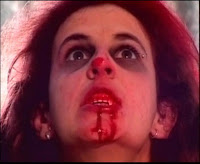This 2006 flick, directed by Olaf Ittenbach, was somewhat of an enigma wrapped in a mystery as it merged some competent filming with one of the worst dialogues ever written but it is not good enough to state that the dialogue was bad, it has to be explained and it will be, later.
The film uses a flashback technique, with action occurring and then flashes to how that scene emerged but I shall look at this pretty much chronologically. It also underpins the story with an interesting cyclic concept that I’ll get to. You’ll notice that the DVD cover says
“For the Undead… there’s no place like home.” Ambiguous but perhaps it refers to vampires?
The film begins with two vehicles going along a mountain road. In the car is Doctor Douglas Madsen (Christopher Kriesa). The other is a prison van. A dying crow in the forest causes a rock to fall and smash the windscreen of Doug’s car, he spins out and causes a crash that allows convicts Stephen (Jaymes Butler), Vincenzo (Mehmet Yilmaz), Arthur (Simon Newby) and Arthur’s brother Spence (Luca Maric) to escape.
A shootout with the guards occurs, during which Spence is shot in the arm. The convicts manage to kill the guards and take their uniforms and then discover that the car has Doug in it, who rather luckily happens to be a doctor, so they take him at gunpoint as both hostage and medic for Spence. Doug, who has trouble walking the woods due to a gammy leg from a car crash as a child that killed his parents and from which he was rescued by a mysterious girl, wants Spence to go to hospital as he might loose his arm. The convicts force march North towards Canada.
Now I want to hit the dialogue here, first. The convicts dialogue is awful and that leads to what might be ridiculous performances but might also be because there was little else to do with the dialogue. Arthur is the worst offender, coming over like a stereotype of an East End gangster with Vincenzo close behind as the convict who should have been commentating on the Discovery Channel’s documentaries.
Anyway, out in the woods they hit fog and become disorientated, emerging into a valley with a large ramshackle lodge. They move towards it and see a girl, we later discover to be called Alice (Martina Ittenbach), bleeding a sheep into a bowl and then putting some form of black paste on the wound to staunch the bleeding. She heads back into the lodge and Doug realises that he might be able to use the paste to help Spence.
They burst into the lodge and catch the occupants at the dinner table. I’ll point out that the meal seems to consist of raw meat (something our protagonists didn’t mention). The Kin, as they call themselves, all wear founding father era clothing and speak in a way that is consistent with the worst dialogue ever found in a film.
Obviously this was Ittenbach’s, and his co-writer Reitmair, idea of what old English must have sounded like and consists of adding “th” at the end of most words and using the most horribly contrived contractions they could think of, which has the effect of making the speech difficult to understand, unwieldy and, to be fair, pretty damn amusing.
In a search for vampires let us note that the windows are all boarded up but, later, we note that they can go out in sunlight. There is also a shrine area, with cross, and the Kin talk often of God. Their leader or elder, Joseph (Klaus Münster), implores the convicts to leave in the name of God, which is ignored and the Kin are placed in a back room under guard as Doug, with the assistance of Alice, goes to work on Spence.
He has to amputate the arm and, in the back room, we see the child of the Kin acting strangely as he cuts. After the operation he takes out a cross he wears and we see a flashback to him as a child, post car accident, with the mysterious woman (clearly now Alice) who gives him the cross. We now know that years have passed and Alice hasn’t aged.
The Kin are brought back into the room but the child is going nuts and so is taken, by the Kin, to the sleeping area and tied down. Then Vincento notices one of the adults is missing, he finds him hidden away with the arm, eating it. All Hell breaks loose and the Kin reveal their true nature, sprouting claws and fangs and being very acrobatic.
The fight is protracted but we realise that the Kin keep coming back. One has his head smashed to a pulp but it reforms and he attacks again. These things cannot seem to die. Doug is left, eventually, and is being attacked but Alice, who has not changed, helps him escape. The Kin drag her off calling her a traitor as he stumbles through the woods straight into a SWAT team who are looking for the prisoners. The fact that Alice saves him as she recognises the cross that she gave him is somewhat analogous to being saved from vampires by weilding a cross, at a push.
Now I said that the film was cyclic, and so it is. Doug is questioned by a cop (Jürgen Prochnow) who doesn’t think his story adds up and has found many different persons' blood on his clothes. From a 'Vamp or Not?' point of view, Doug does ask if the cop believes in Demons. As the cop believes Doug to be being deliberately uncooperative he arrests him as a suspect (for 30 days questioning) and has him transported to prison. The prison bus goes off the road, in another crow related accident, at the exact same spot.
Doug finds himself being traipsed through the woods by four convicts again, one of them, George (Wolfgang Müller) is injured (this time in the groin), there are also Jimmy (Daryl Jackson), Shawn (James Matthews) and Paul (Dan van Husen, who we last saw in
Forest of the Damned). In the ridiculous dialogue stakes, Paul comes out top as the intellectual, scenery loving thug – yet somehow van Husen makes it work in a surreal way.
We know that they will end up back at the lodge but there are one or two things to note in the “Vamp or Not?” stakes. Alice is alone, the others are hunting. She says that they are Kin but not family and had hidden themselves away to resist temptation – but the taste of human blood has sparked a thirst in the others. Whilst we have seen them eat flesh the primary goal is explained as
“Killeth they for blood.” Alice states that the thirst sleeps in her.
The film does come across as, what I imagine as I haven’t watched it, The Village meets
From Dusk till Dawn. The latter is not surprising as Ittenbach also directed Legion of the Dead, which itself owed a huge dept to the Rodriguez/ Tarantino vehicle. Is it, however, Vamp?
The Kin could be a few things. They are mentioned, on the box, as undead – originally a direct vampire reference but, in recent years, more often a zombie reference. These are not zombies however. They grow fangs and thirst for blood, they do not age. This could be either vampiric or demon. The fact that religious icons do not effect them is a strike against either of those creatures, but more so demons. The fact that they say they are cursed, and that they are from different families drawn together because of the curse lends towards a communicable thing like vampirism.
They do not seem to be able to die, at all. There is a question mark over fire as one is set alight towards the end but we do not know if it recovers. It is touch and go but enough, I think, to put this film on the Vamp radar at least. To be honest, if you get past the awful dialogue, it is a competent and interesting little flick.
The imdb page is
here.

































































